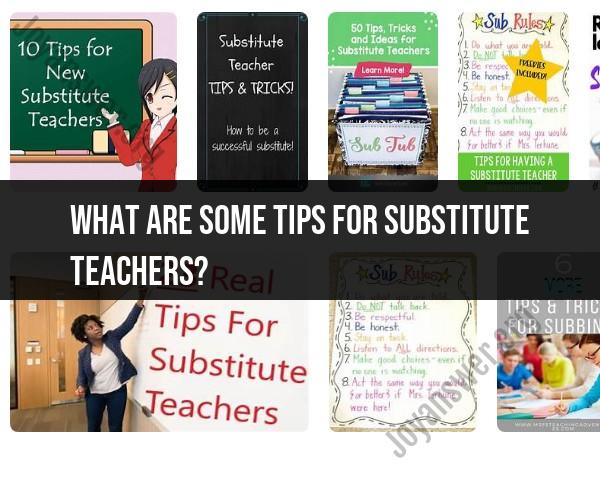What are some tips for substitute teachers?
Being a substitute teacher comes with its unique set of challenges and opportunities. Here are some tips to help substitute teachers navigate their role effectively:
Before the Assignment:
Familiarize Yourself:
- Review lesson plans and materials left by the regular teacher.
- Understand classroom procedures, rules, and emergency protocols.
Arrive Early:
- Arrive well before the students to familiarize yourself with the classroom and any equipment you might need.
Introduce Yourself:
- Greet students and introduce yourself, setting a positive tone for the day.
- Be clear about your expectations and the importance of respectful behavior.
Establish Authority Respectfully:
- Firmly but respectfully establish your authority in the classroom.
- Consistency and fairness are key to gaining students' respect.
During the Assignment:
Follow Lesson Plans:
- Stick to the lesson plans as closely as possible.
- If modifications are necessary, document them and inform the regular teacher.
Be Adaptable:
- Be ready to adapt to unexpected situations or changes in schedule.
- Flexibility is a valuable trait for substitute teachers.
Use Students' Names:
- Make an effort to learn and use students' names. This helps build rapport and manage the classroom more effectively.
Enforce Classroom Management:
- Be consistent in applying classroom rules.
- Address disruptions promptly and fairly while maintaining a calm demeanor.
Encourage Student Engagement:
- Keep students engaged through interactive activities, discussions, or other methods.
- Use positive reinforcement to acknowledge good behavior.
Be Approachable:
- Encourage students to ask questions or seek help when needed.
- Create an approachable and supportive atmosphere.
Leave Feedback:
- Provide feedback to the regular teacher about how the day went, any challenges faced, and how well students followed the lesson plan.
After the Assignment:
Leave Detailed Notes:
- Write detailed notes for the regular teacher, including what was covered, any issues that arose, and outstanding student behavior.
Express Gratitude:
- Thank the students for their cooperation and the regular teacher for the opportunity to substitute.
Reflect on the Experience:
- Reflect on the day, considering what went well and areas for improvement.
- Use each experience as a learning opportunity.
Build a Substitute Teaching Toolkit:
- Create a toolkit with essential supplies, emergency information, and strategies for different grade levels.
- Include activities that can be used as fillers or enrichment.
Professionalism and Communication:
Dress Professionally:
- Dress appropriately and professionally to set a positive example for students.
Communicate with Staff:
- Communicate with school staff, including administrators and other teachers.
- Be open to seeking guidance if needed.
Establish a Network:
- Build connections with other substitute teachers and school staff.
- Networking can provide valuable insights and support.
Being a substitute teacher requires adaptability, effective communication, and a positive attitude. By following these tips, substitute teachers can create a positive learning environment and contribute to a successful day in the classroom.
What are effective tips or strategies for individuals working as substitute teachers?
Being a substitute teacher can be both rewarding and challenging. Here are some effective tips and strategies to help you thrive in this role:
Preparation:
- Be familiar with the school's policies and procedures: Review the school handbook and any specific instructions left by the regular teacher. Knowing routines for attendance, fire drills, and classroom management will make you feel more confident.
- Review lesson plans and materials: Familiarize yourself with the planned activities for the day, including any handouts, audiovisual aids, or specific instructions. This will help you stay on track and avoid surprises.
- Prepare a few backup activities: Have some engaging and age-appropriate activities in your bag in case the planned lesson runs short or doesn't go as expected. Simple games, puzzles, or creative exercises can be lifesavers.
Classroom Management:
- Establish clear expectations: Set classroom rules and routines at the beginning of the day, and be consistent in enforcing them. Speak in a confident and authoritative tone, but remain approachable.
- Get to know your students: Learn their names and interests as much as possible. This helps build rapport and creates a more positive learning environment.
- Engage with your students: Use a variety of teaching methods to keep students interested and active. Ask questions, encourage participation, and be flexible with your approach if needed.
- Address disruptive behavior promptly and fairly: Don't be afraid to address disruptive behavior calmly but firmly. Use established consequences consistently and follow through when necessary.
Communication:
- Communicate effectively with the regular teacher: Leave detailed notes about the day's activities, any student concerns, and any important information you learned. This helps ensure continuity in the learning process.
- Communicate clearly with students: Be clear and concise in your instructions and explanations. Avoid jargon and use language appropriate for the age group.
- Be approachable and available: Let students know you are there for them if they have questions or need help. Be open to their feedback and willing to adapt your approach based on their needs.
Professionalism:
- Dress professionally: Make a good first impression by dressing appropriately for the school environment.
- Arrive on time and be prepared: Punctuality and preparedness demonstrate professionalism and respect for the students, teachers, and school.
- Maintain a positive attitude: Your attitude is contagious. Approach each day with enthusiasm and a positive outlook, even when faced with challenges.
Additional Resources:
- Substitute teacher associations: Many states or regions have associations that offer support, resources, and professional development opportunities for substitute teachers.
- Online resources: There are many websites and blogs dedicated to substitute teaching, offering tips, strategies, and lesson plan ideas.
- Mentorship programs: Some schools or districts offer mentorship programs for new substitute teachers, which can provide valuable guidance and support.
By following these tips and staying adaptable, you can make your substitute teaching experience positive and rewarding for yourself and the students you encounter. Remember, you are playing a vital role in ensuring the continuity of learning and creating a positive learning environment for all.













